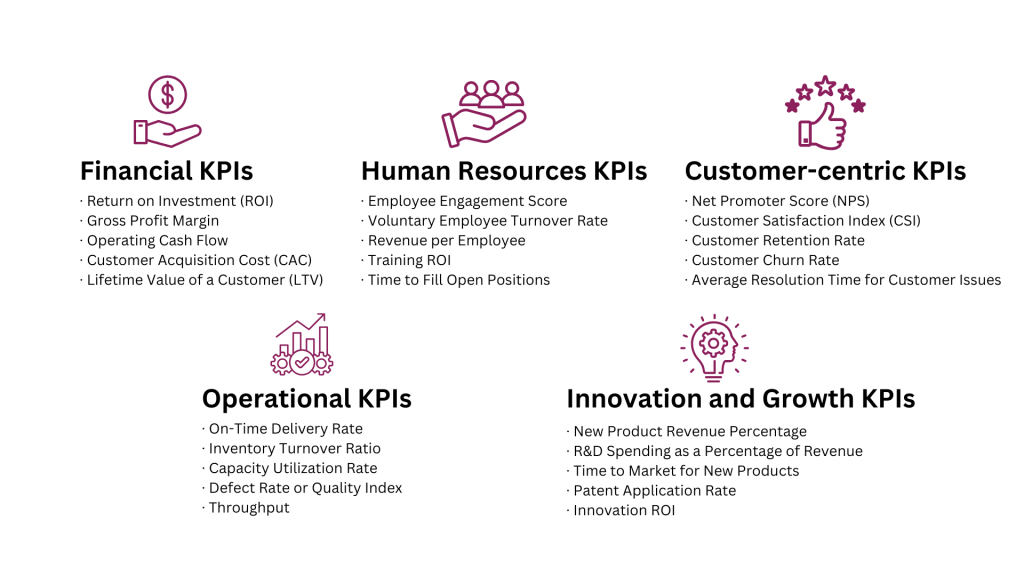
In the fast-paced, ever-evolving landscape of modern business, C-suite executives face the constant challenge of steering their organizations towards success. Amidst the complexity of global markets, technological disruptions, and shifting consumer behaviours, one tool stands out as a beacon for strategic deployment: Key Performance Indicators (KPIs). These quantifiable metrics serve as the compass by which executives can chart their course, aligning organizational efforts with overarching strategic objectives.
The Crucial Role of KPIs in Strategy Alignment
The importance of KPIs in strategic goal alignment cannot be overstated. They provide a clear, measurable link between daily operations and long-term vision, enabling executives to translate lofty aspirations into tangible, actionable targets. By distilling complex business processes into comprehensible metrics, KPIs offer a common language that bridges the gap between boardroom strategies and frontline execution.
However, the true power of KPIs lies not merely in their ability to measure performance, but in their capacity to drive it. When carefully selected and strategically implemented, KPIs become catalysts for organizational transformation, fostering a culture of accountability, innovation, and continuous improvement. They serve as the lever upon which executives can leverage their strategic decision-making, ensuring that every action taken is in the service of the company’s overarching goals.
In this comprehensive exploration, we will delve deep into the world of KPIs, unveiling their potential to revolutionize strategic alignment and drive unprecedented organizational success. From understanding the fundamental nature of KPIs to mastering the art of selection and implementation, this guide will equip C-suite executives with the knowledge and tools needed to harness the full power of performance metrics in today’s competitive business environment.
Understanding KPIs
At their core, Key Performance Indicators (KPIs) are quantifiable measurements used to gauge an organization’s performance in relation to its strategic objectives. For C-suite executives, KPIs serve as a vital link between high-level strategy and day-to-day operations, providing a clear and concise snapshot of organizational health and progress towards defined goals.
KPIs for performance
The significance of KPIs for the C-suite extends far beyond mere performance measurement. These metrics act as a strategic compass, guiding executive decision-making and resource allocation. They provide the empirical foundation upon which leaders can base their strategic choices, moving beyond intuition and guesswork to data-driven insights.
Communicating through KPIs
Moreover, KPIs serve as a powerful communication tool, both within the organization and with external stakeholders.
Internal stakeholders
They distill complex business processes and outcomes into easily digestible metrics, facilitating alignment across departments and hierarchical levels. The true power of KPIs lies in their ability to focus organizational attention and effort. By highlighting specific areas of performance, KPIs signal to every member of the organization what truly matters in the pursuit of strategic objectives. This focusing effect can drive innovation, efficiency, and continuous improvement across all levels of the company. For shareholders and board members, KPIs offer tangible evidence of the organization’s progress and the effectiveness of its leadership.
External Stakeholders
Key Performance Indicators (KPIs) serve as a critical tool for both suppliers and customers, acting as a catalyst for improvement and innovation within their partnership. By providing measurable and quantifiable data, KPIs offer a clear picture of how the partnership is performing. This transparency enables both parties to identify and address ongoing challenges efficiently, ensuring that potential issues are managed proactively. Moreover, KPIs highlight areas where the partnership is excelling, revealing opportunities for deeper and more effective collaboration. By focusing on these metrics, suppliers and customers can work together to enhance processes, improve product quality, and ultimately drive mutual growth and success. This results in a more resilient and adaptive partnership, capable of thriving in a competitive market landscape.
Types of KPIs
However, it’s crucial for C-suite executives to understand that not all metrics qualify as KPIs. True KPIs are intrinsically linked to strategic objectives and have a significant impact on organizational success. We can separate indicators in two main categories.
Leading Indicators
Imagine you’re managing a retail store. A leading indicator for your business might be the number of customers entering the store each day. This is an operational metric that provides real-time information about current activity. If you notice a sudden drop in foot traffic, it might signal that your marketing efforts need adjustment or that there’s a problem with your store’s appeal. By monitoring this leading indicator, you can make timely changes to your strategy, such as launching a new advertising campaign or rearranging the store layout, to ensure you meet your sales targets.
Lagging Indicators
Now, consider the store’s monthly sales figures. These are lagging indicators because they reflect past performance—how well your store did over the past month. Once you have these figures, it’s like looking at a snapshot of what happened. Although these indicators don’t provide immediate insights for real-time decision-making, they are crucial for understanding trends, such as seasonal variations in sales or the effectiveness of past marketing strategies. By analyzing this data, you can identify challenges, such as a decline in a particular product category, and adjust future actions, like revising inventory orders or introducing promotions to increase sales. In summary, leading indicators help you make adjustments in the present to stay on track, while lagging indicators give you a retrospective view that can inform future strategies. Both are essential for a comprehensive understanding of business performance and planning.
Multifaceted role of KPIs
In the context of strategic goal alignment, KPIs play a multifaceted role:
- Goal Clarification: KPIs help translate broad strategic objectives into specific, measurable targets, ensuring that goals are clearly understood across the organization.
- Performance Tracking: They provide a standardized method for monitoring progress towards strategic goals, allowing for timely interventions and course corrections.
- Accountability: By assigning specific KPIs to departments or individuals, executives can create a culture of ownership and responsibility for strategic outcomes.
- Decision Support: KPIs offer data-driven insights that inform strategic decision-making, helping executives allocate resources and prioritize initiatives more effectively.
- Organizational Alignment: Well-chosen KPIs can help break down silos and foster collaboration by highlighting interdependencies between different areas of the business.
As we delve deeper into the nuances of KPI selection and implementation, it’s important to keep in mind that the true value of KPIs lies not in the metrics themselves, but in how they are used to drive strategic alignment and organizational success. Key Performance Indicators, or KPIs, serve as catalysts for fostering teamwork, sparking ongoing enhancement, and fuelling perpetual learning. Each discussion surrounding their outcomes should centre on deciphering past events and pinpointing strategies for improvement. However, when organizations wield KPIs as instruments of reprimand and assign blame, the repercussions can be severe. Such misuse not only undermines their purpose but also erodes employee morale and dampens engagement, ultimately leading to counterproductive results.
Selecting the Right KPIs for Strategy Alignment
The process of selecting the right Key Performance Indicators (KPIs) is both an art and a science. It requires a deep understanding of the organization’s strategic objectives, industry dynamics, and operational realities. For C-suite executives, the challenge lies in identifying metrics that not only reflect current performance but also drive future success.
Criteria for selection
When selecting KPIs, executives should consider the following criteria:
- Strategic Alignment: Each KPI should have a clear, direct link to the organization’s strategic objectives. It should measure progress towards specific goals rather than just tracking general performance.
- Actionability: The metric should be something that the organization can influence through its actions. KPIs that are outside of the company’s control may be interesting to track but are less useful for driving performance improvements.
- Measurability: KPIs must be quantifiable and consistently measurable over time. This ensures that progress can be tracked accurately and compared across different periods.
- Timeliness: The data for the KPI should be available frequently enough to allow for timely decision-making and course corrections.
- Clarity: All stakeholders, from frontline employees to board members, need to easily understand what KPIs mean. Complex or ambiguous metrics can lead to confusion and misalignment. Their definition and calculation methodology should be accessible to all.
- Balance: The set of KPIs should provide a balanced view of organizational performance. They must cover different aspects such what is shown in figure 1.
- Benchmarkability: Ideally, the KPI should allow for comparison with industry benchmarks or competitors, providing context for the organization’s performance.
- Access to data: When data is readily available, it means that people can easily find and use the information they need. This makes it easier for businesses and organizations to make informed decisions.
- The quality of the data: it refers to how accurate, reliable, and up-to-date the information is. High-quality data helps in drawing correct conclusions and making effective plans.
Examples of KPis for strategy alignment
With these criteria in mind, let’s explore some examples of effective KPIs across different business functions:

However, it’s important to note that the most effective KPIs are often unique to an organization’s specific strategy and industry context. While industry-standard metrics provide valuable benchmarks, C-suite executives should not shy away from developing custom KPIs that capture the unique drivers of their organization’s success.
Furthermore, the process of selecting KPIs should be iterative and adaptive. As the business environment evolves and strategic priorities shift, executives must be prepared to reevaluate and adjust their KPIs accordingly. This ongoing refinement ensures that the organization’s metrics remain relevant and continue to drive strategic alignment effectively.
In our next article, we will address how to ensure a cohesive approach throughout the departments as well as discuss how KPIs enhance strategic decision-making.
Achieve Excellence with the right Key Performance Indicators! Learn how we can guide your team towards continuous improvement and optimized performance. Book a free call with our experts today!
____________________________________
About Veronica B. Marquez

I help growing manufacturing and service organizations scale without chaos—by turning operational challenges into sustainable performance gains. My superpower is making strategy real at every level of the business: connecting people, processes, and purpose to drive productivity, engagement, and resilience. I bring clarity to complexity and help teams execute better, faster, together. Through a proven lens of operational excellence, continuous improvement, and supply chain optimization, I work with leaders to align efforts, simplify execution, and create systems that actually support growth.
Named one of the Top 50 Experts in Operational Excellence by the PEX Network, I bring over 20 years of experience across sectors like manufacturing, distribution, mining, and public services. I teach Lean Six Sigma at the executive education level, lecture on service design in a master’s program, and host a LinkedIn Live series focused on Excellence in Industry 5.0. Ready to explore how operational excellence can transform your business? Reach out https://www.linkedin.com/in/veronicabm/.
📷 Canva








